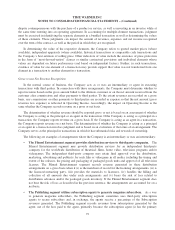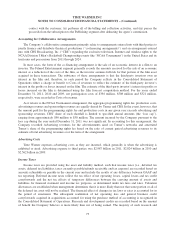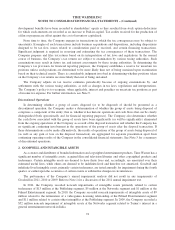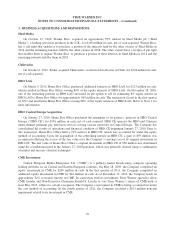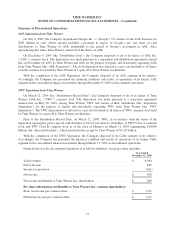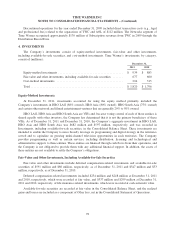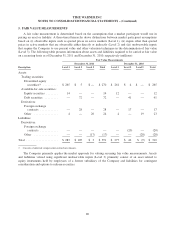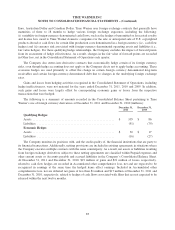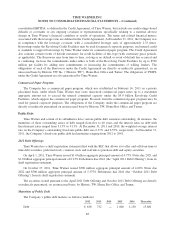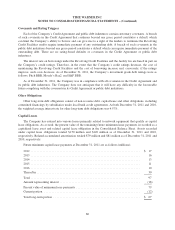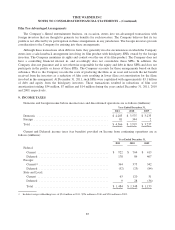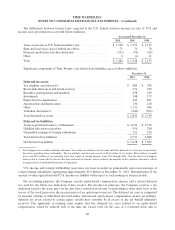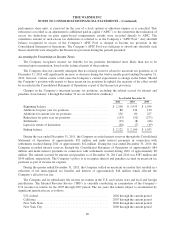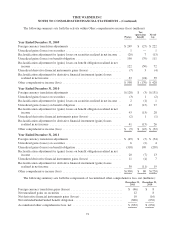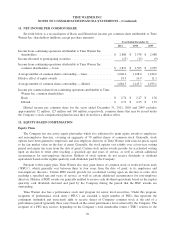Time Magazine 2011 Annual Report Download - page 96
Download and view the complete annual report
Please find page 96 of the 2011 Time Magazine annual report below. You can navigate through the pages in the report by either clicking on the pages listed below, or by using the keyword search tool below to find specific information within the annual report.
TIME WARNER INC.
NOTES TO CONSOLIDATED FINANCIAL STATEMENTS – (Continued)
a film that management plans to abandon is zero. As the primary determination of fair value is determined using
a DCF model, the resulting fair value is considered a Level 3 measurement. During the year ended December 31,
2011, certain film costs, which were recorded as inventory in the Consolidated Balance Sheet, were written down
to $400 million from their carrying value of $511 million. During the year ended December 31, 2010, certain
film costs, which were recorded as Inventories in the Consolidated Balance Sheet, were written down to $81
million from their carrying value of $168 million.
6. INVENTORIES AND FILM COSTS
Inventories and film costs consist of (millions):
December 31,
2011
December 31,
2010
Inventories:
Programming costs, less amortization ............................ $ 3,321 $ 3,441
DVDs, books, paper and other merchandise ........................ 340 360
Total inventories ............................................. 3,661 3,801
Less: current portion of inventory ................................ (1,890) (1,920)
Total noncurrent inventories .................................... 1,771 1,881
Film costs — Theatrical:(a)
Released, less amortization ..................................... 844 655
Completed and not released .................................... 295 166
In production ................................................ 1,592 1,379
Development and pre-production ................................ 87 98
Film costs — Television:(a)
Released, less amortization ..................................... 1,141 929
Completed and not released .................................... 360 300
In production ................................................ 499 571
Development and pre-production ................................ 5 6
Total film costs .............................................. 4,823 4,104
Total noncurrent inventories and film costs ........................ $ 6,594 $ 5,985
(a) Does not include $1.320 billion and $1.498 billion of net film library costs as of December 31, 2011 and December 31, 2010,
respectively, which are included in Intangible assets subject to amortization in the Consolidated Balance Sheet.
Approximately 92% of unamortized film costs for released theatrical and television product are expected to
be amortized within three years from December 31, 2011. In addition, approximately $1.8 billion of the film
costs of released and completed and not released theatrical and television product are expected to be amortized
during the twelve-month period ending December 31, 2012. At December 31, 2011 and 2010, there were $182
million and $208 million, respectively of unamortized computer software costs related to videogames included
within theatrical film costs. Amortization of such costs was $163 million, $40 million and $57 million for the
years ended December 31, 2011, 2010 and 2009, respectively.
7. DERIVATIVE INSTRUMENTS
Time Warner uses derivative instruments, principally forward contracts, to manage the risk associated with
the volatility of future cash flows denominated in foreign currencies and changes in fair value resulting from
changes in foreign currency exchange rates. The principal currencies being hedged include the British Pound,
82


